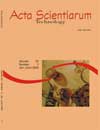<b>Exame de caso sobre o método de graus-dia para avaliação do desempenho energético de uma edificação unifamiliar</b> - DOI: 10.4025/actascitechnol.v31i1.305
DOI:
https://doi.org/10.4025/actascitechnol.v31i1.305Palavras-chave:
método graus-dia, coeficiente total de perda de calor, desempenho energético de uma edificação.Resumo
O presente trabalho utilizou o método de graus-dia para avaliação do desempenho energético de uma edificação unifamiliar ao mostrar que, na concepção de um projeto arquitetônico, devem ser sempre considerados os materiais empregados na edificação e o tamanho das aberturas. O desempenho energético foi obtido por meio do modelo de graus-dia, considerando-se a localização da residência unifamiliar nas cidades de Cascavel, Curitiba, Foz do Iguaçu e Londrina. Para isso, foram obtidos os dados climáticos dessas localidades e, em um segundo momento, obteve-se o coeficiente total de perda de calor na edificação unifamiliar preestabelecida, avaliando-se, assim, as condições de conforto térmico e o desempenho energético da edificação. Observou-se que graus-dia de aquecimento, no inverno, são de 77,78 para Curitiba e de 0,00 para Foz do Iguaçu, na temperatura-base de 14°C, e que os graus-dia de resfriamento são de 30,17 no inverno. A energia consumida em Foz do Iguaçu para aquecer a residência é de 2.367,88 kWh anual e o consumo de energia anual para aquecer a residência em Curitiba é de 6.277,02 kWh, para ITA = 2 e 20% de abertura, com vidros duplos.Downloads
Downloads
Publicado
Como Citar
Edição
Seção
Licença
DECLARAÇíO DE ORIGINALIDADE E DIREITOS AUTORAIS
Declaro que o presente artigo é original, não tendo sido submetido í publicação em qualquer outro periódico nacional ou internacional, quer seja em parte ou em sua totalidade.
Os direitos autorais pertencem exclusivamente aos autores. Os direitos de licenciamento utilizados pelo periódico é a licença Creative Commons Attribution 4.0 (CC BY 4.0): são permitidos o compartilhamento (cópia e distribuição do material em qualqer meio ou formato) e adaptação (remix, transformação e criação de material a partir do conteúdo assim licenciado para quaisquer fins, inclusive comerciais.
Recomenda-se a leitura desse link para maiores informações sobre o tema: fornecimento de créditos e referências de forma correta, entre outros detalhes cruciais para uso adequado do material licenciado.



















